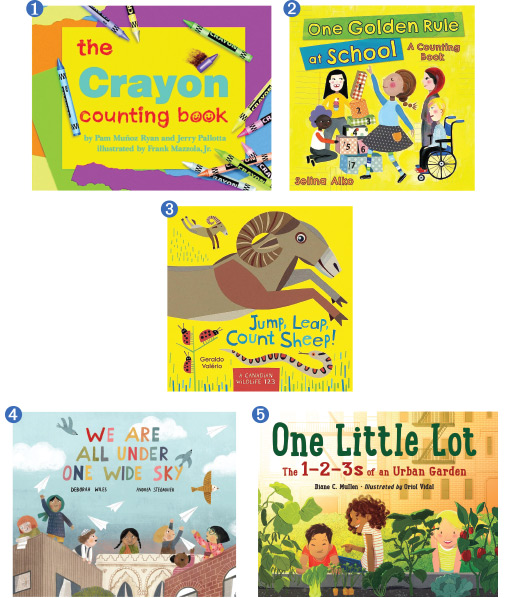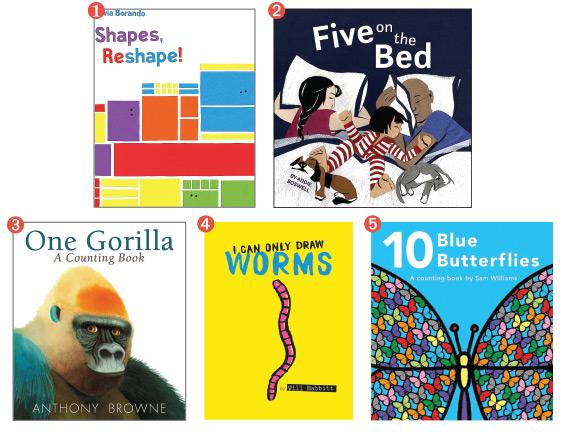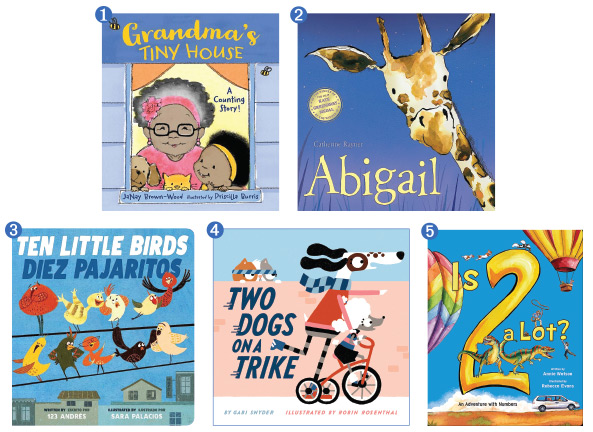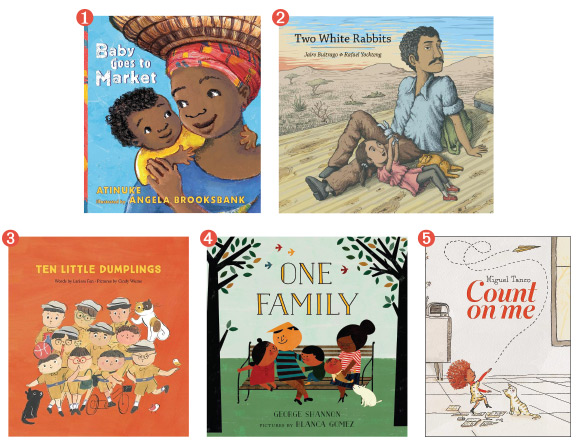Reading by Numbers: Four Types of Counting Books
A team of librarians and academics identifies different kinds of counting books and recommends titles and read-aloud strategies for each.
|
|
Mie-Mie Wu reads aloud. |
4 categories in Counting Books: |
“One, two, three, four–but Baby eats one!” Children and adults hold up fingers as they joyfully count together during library story time. Mie-Mie Wu, children’s librarian at Bothell (WA) Library, is reading aloud Baby Goes to Market by Atinuke, illustrated by Angela Brooksbank. Pointing to an illustration, Mie-Mie asks, “How many biscuits do you see?” As children gesture, she adds, “I hear you counting, four, eight, twelve, MORE!”
Counting books are a beloved tradition at library story time, as Mie-Mie’s enthusiastic audience confirms. They discuss illustrations and ideas, explore number concepts, and encourage the kinds of talk important to developing math skills and concepts. In the work of mathematizing children’s literature—seeing stories through a mathematical lens—we listen to kids’ ideas and facilitate discussions of joyful and complex math.
As we engaged with counting books of all sorts, we began to wonder: What counts as a counting book? Is there a range of characteristics or features of counting books? And finally, how might we more deeply explore and discuss concepts of number and quantity with children?
Thumbing through stacks of counting books, we discovered that this popular genre has a huge variety of features. Some march in sequence from 1–10, while others skip-count by odd or even numbers or jump by tens into the hundreds. Some represent numbers in multiple ways, while others scarcely mention numbers that are nearly hidden in story events.
We were drawn to books that spoke to broader themes of people and society, as they generate discussions of family, community, and life issues. The range of mathematical and story content across the counting book genre is exciting. As we read and sorted hundreds of books by theme, characteristics, and features, we identified four overlapping categories: traditional counting books, counting books with added elements, storybooks with counting, and conceptual books with a quantity focus.
Counting books are rich with read-aloud possibility. As you explore them in your library, keep an eye out for new and interesting titles, and think about how to find joy and wonder for counting! Here’s more insight into those categories, along with suggested books and spotlighted titles.
Traditional counting booksThese works are the ones that most likely come to mind when you think of the genre. They emphasize learning numbers and the counting sequence. Like The Crayon Counting Book by Pam Muñoz Ryan and Jerry Pallotta, illustrated by Frank Mazzola Jr., the books we identified as “traditional” tend to include the numeral (i.e., 4), the word for the numeral (four), and an image of the corresponding quantity (four crayons).
Everyone feels comfortable reading aloud and exploring traditional counting books, and that creates a sense of positive energy. Everyone can read interactively, counting out loud or in their minds. A traditional counting book instantly draws upon the human desire to quantify. It’s straightforward and approachable. When reading these aloud, ask what else besides counting is happening in the story, and how can we connect these ideas to our experiences? Traditional counting books tend to: ● focus on numbers in the ones and teens, with numbers in ascending order; ● represent numbers by words, symbols, and illustrations; ● feature opportunities for children to count with one-to-one correspondence and develop cardinality. Jump, Leap, Count Sheep! Some counting books have a tendency for symmetry and sameness. In this book, we see more uniqueness. Celebrating Canadian wildlife, it shows groupings of animals depicted in a variety of sizes, shapes, and proportions, all actively doing something together. There’s immediately something to seize on, notice, and count. Examples ❶ One Golden Rule at School: A Counting Book by Selina Alko. Henry Holt. 2020. ➋ One Little Lot: The 1-2-3s of an Urban Garden by Diane C. Mullen, illus. by Oriol Vidal. Charlesbridge. 2020. ➌ The Crayon Counting Book by Pam Muñoz Ryan and Jerry Pallotta, illus. by Frank Mazzola Jr. Charlesbridge. 1996. ➍ Jump, Leap, Count Sheep! by Geraldo Valério. Owl Kids. 2017. ➎ We Are All Under One Wide Sky by Deborah Wiles, illus. by Andrea Stegmaier. Sounds True. 2021. |
Back to the top
Counting books with added elementsThese books retain the characteristics of traditional counting books but with more features. In One Gorilla: A Counting Book, for example, Anthony Browne extends the book beyond basic number concepts with vivid illustrations of different kinds of primates, all with unique faces and expressions. These individuals are part of a small set within the larger set of primates. Discussions of these primate sets can include counting and exploring of same and different groupings and numbers.
Counting books with added elements tend to: ● focus on numbers, ones and teens and beyond; ● order numbers in unusual or surprising ways; ● include elements such as positional words, strong characters, or humor; ● feature additional interest or intrigue. This seemingly simple text comes to life with sharp graphics: bold, crisp, clear images in collage. These draw attention to the unique individuals, highlighting movements and independent choices. Yet in the warm family context, all come together in a group with a sense of wholeness. The pages showing “none” and asking “none?” pose visual questions and cues: “Where did everybody go? Who’s under the rumpled covers?” The story highlights directional prepositions while spotlighting a reassuring environment—a cozy bed on a lazy weekend. Counting forward and backward, we see the playfulness of gathering in bed and hiding under the covers—and what child, or pet, hasn’t done that? Examples ❶ Shapes, Reshape! by Silvia Borando. Candlewick. 2016. ➋ Five on the Bed by Addie Boswell. West Margin. 2020. ➌ One Gorilla: A Counting Book by Anthony Browne. Candlewick. 2013. ➍ I Can Only Draw Worms by Will Mabbitt. Penguin Workshop. 2019. ➎ 10 Blue Butterflies by Sam Williams. Boxer Bks. 2018. |
Back to the top
Storybooks with countingThis category of counting books has narrative and plot twists. Counting is still present, even prominent, but the story demands as much attention (or more) as the counting. Through number and story, these books let children relate concepts of number to their own lives and experiences. Additionally, storybooks with counting, including puzzles, rhymes, and actual problems to be solved, nurture older and more experienced readers’ cognitive and language development as well as mathematical problem identification and solving skills.
These books allow for deeper engagement. Readers and listeners can reflect on observations, experiences, even family practices, when connecting to the story. There’s more meaning behind quantity, as opposed to just quantity front and center. This story shows a large, extended, intergenerational family gathering. The tiny house may be a small space, but there is an abundance of family, food, joy, and love. One fun element: every group of arrivals shows up with one more thing they’re bringing for the potluck, spotlighting the idea of extra or enough. This celebration of togetherness and abundance is about “more” in a good way. Storybooks with counting tend to: ● focus on story but with number/quantity content; ● include unexpected elements; ● order numbers in an unusual manner or may be subtle in terms of quantity; ● embed number/quantity in story context. Examples: ❶ Grandma’s Tiny House by JaNay Brown-Wood, illus. by Priscilla Burris. Charlesbridge. 2021. ➋ Abigail by Catherine Rayner. Tiger Tales. 2013. ➌ Ten Little Birds by 123 Andrés, illus. by Sarah Palacios. Scholastic. 2021. ➍ Two Dogs on a Trike by Gabi Snyder, illus. by Robin Rosenthal. Abrams/Appleseed. 2020. ➎ Is 2 a Lot? by Annie Watson, illus. by Rebecca Evans. Tilbury. 2019. |
Back to the top
Conceptual books with a quantity focusThis category pushed our thinking about what counts as a counting book.
Conceptual books with strong themes and narrative elements help kids relate story with their everyday experiences, shaping the nature of quantity representations and helping them see numbers in meaningful contexts.
Conceptual books with a quantity focus tend to: ● focus on story with deeper connections to narrative, plot, and character; ● emphasize narrative with subtle quantity content; ● embed number or quantity deeply within the context and story; ● feature vivid illustrations to learn about and discuss diversity. Baby Goes to Market Baby is consuming goods from the market and putting other goods, unnoticed, in Mama’s basket—until, at the end, Mama notices all the goods she did not buy. Certainly there are objects to count on each page, but the numbers don’t go from 1–10. The action, rhythm, events, and the idea of Mama and Baby getting into trouble (and realizing the strong community around them), are key to this delightful tale. Two White Rabbits This story has no overt counting or connections to quantity/number except the title. A father and daughter are fleeing; they are refugees trying to find their way to a new home. This story introduces the uncertainty people crossing borders face, showing risk and danger, whether from coyotes, fatigue, or exhaustion. Questions arise: “Who are they leaving behind?” The girl feels safe with her dad and two stuffed rabbits. A powerful opportunity to talk about refugees, migrants, and immigration. And it all begins with simple numbers: two people on a journey and two white rabbits. Examples: ❶ Baby Goes to Market by Atinuke, illus. by Angela Brooksbank. Candlewick. 2017. ➋ Two White Rabbits by Jairo Buitrago, tr. from Spanish by Elisa Amado, illus. by Rafael Yockteng. Groundwood. 2015. ➌ Ten Little Dumplings by Larissa Fan, illus. by Cindy Wume. Tundra. 2021. ➍ One Family by George Shannon, illus. by Blanca Gomez. Farrar. 2022. ➎ Count on Me by Miguel Tanco. Tundra. 2019. |
Back to the top
Allison Hintz and Antony T. Smith are associate professors in the School of Educational Studies at the University of Washington, Bothell. Mie-Mie Wu is a children’s services librarian at the Bothell Library, King County Library System.
RELATED
The job outlook in 2030: Librarians will be in demand
The job outlook in 2030: Librarians will be in demand
ALREADY A SUBSCRIBER? LOG IN
We are currently offering this content for free. Sign up now to activate your personal profile, where you can save articles for future viewing



 Traditional counting books provide an opportunity for young children to learn the connection between number name, symbol, and quantity. For instance, “4” is the same as “four” is the same as one, two, three, four items. Children can practice one-to-one correspondence, a foundational skill of pointing to one item and saying one number word for each. Children can also practice cardinality, understanding that the last count word in the counting sequence represents the total number of items in the collection.
Traditional counting books provide an opportunity for young children to learn the connection between number name, symbol, and quantity. For instance, “4” is the same as “four” is the same as one, two, three, four items. Children can practice one-to-one correspondence, a foundational skill of pointing to one item and saying one number word for each. Children can also practice cardinality, understanding that the last count word in the counting sequence represents the total number of items in the collection. With these books, readers make connections or speculate on relationships that occur to them as they hear, read, or re-read the story. These conversations and speculations are always interactive. Readers and listeners create room to explore and ways to open up the narrative. The added element is identifying or determining the playful purpose the author and illustrator bring to the story.
With these books, readers make connections or speculate on relationships that occur to them as they hear, read, or re-read the story. These conversations and speculations are always interactive. Readers and listeners create room to explore and ways to open up the narrative. The added element is identifying or determining the playful purpose the author and illustrator bring to the story.
 These books offer freedom to interpret the story and the counting/number content. Ask, “What do you notice? What do you wonder?” A story told through numbers and quantity may prompt discussion of other math concepts and encourage children to see quantity in operation in the world around them.
These books offer freedom to interpret the story and the counting/number content. Ask, “What do you notice? What do you wonder?” A story told through numbers and quantity may prompt discussion of other math concepts and encourage children to see quantity in operation in the world around them.



Add Comment :-
Be the first reader to comment.
Comment Policy:
Comment should not be empty !!!